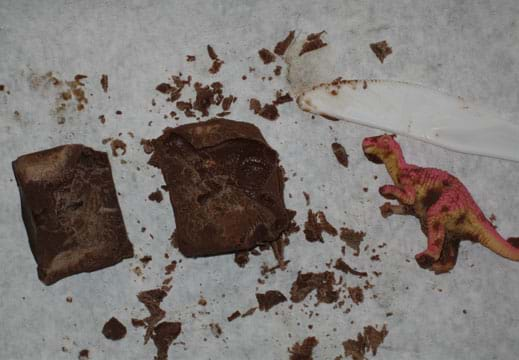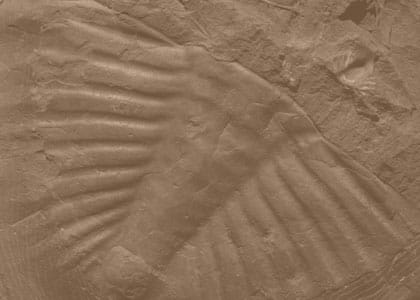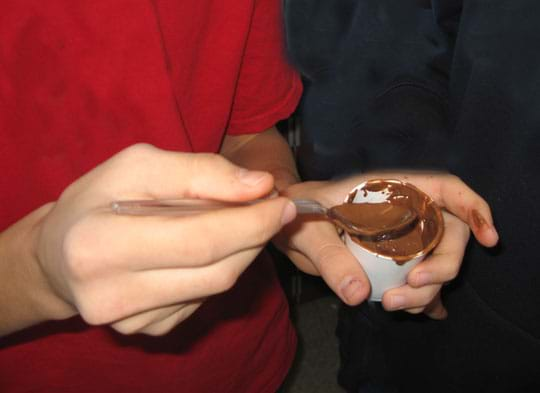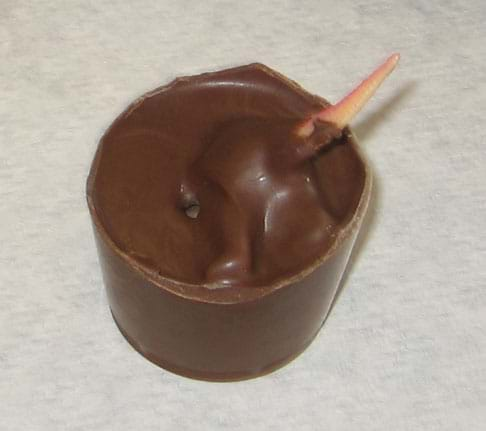Quick Look
Grade Level: 7 (6-8)
Time Required: 1 hour
Two 30-minute time periods, separated by at least one hour
Expendable Cost/Group: US $2.00
Group Size: 2
Activity Dependency: None
Subject Areas: Earth and Space
Summary
To understand how fossils are formed, students model the process of fossilization by making fossils using small toy figures and melted chocolate. They extend their knowledge to the many ways that engineers aid in the study of fossils, including the development of tools and technologies for determining the physical and chemical properties of fossilized organisms, and how those properties tell a story of our changing world.
Engineering Connection
Engineers design tools to help us learn about our natural world and how we can help people thrive. As fossils are uncovered, and previously unknown organisms are discovered, engineers learn how our world is changing. Fossil discoveries inspire the development of advanced engineering technologies to locate and even create 3-D images of prehistoric organisms. Engineers recreate how these organisms may have moved to get new ideas for new technologies or processes. By searching out the physical and chemical changes to the environment, engineers apply their knowledge to create processes to address global warming, as well as develop products that mimic prehistoric capabilities.
Learning Objectives
After this activity, students should be able to:
- Define fossil.
- Describe how fossils are created.
- Explain why an engineer might study fossils.
- Utilize the design process to develop and systematically compare ideas for tools that perform one or more of the following objectives: extract fossils, investigate the physical and/or chemical properties of fossils, or prevent future extinctions.
Educational Standards
Each TeachEngineering lesson or activity is correlated to one or more K-12 science,
technology, engineering or math (STEM) educational standards.
All 100,000+ K-12 STEM standards covered in TeachEngineering are collected, maintained and packaged by the Achievement Standards Network (ASN),
a project of D2L (www.achievementstandards.org).
In the ASN, standards are hierarchically structured: first by source; e.g., by state; within source by type; e.g., science or mathematics;
within type by subtype, then by grade, etc.
Each TeachEngineering lesson or activity is correlated to one or more K-12 science, technology, engineering or math (STEM) educational standards.
All 100,000+ K-12 STEM standards covered in TeachEngineering are collected, maintained and packaged by the Achievement Standards Network (ASN), a project of D2L (www.achievementstandards.org).
In the ASN, standards are hierarchically structured: first by source; e.g., by state; within source by type; e.g., science or mathematics; within type by subtype, then by grade, etc.
NGSS: Next Generation Science Standards - Science
-
CCC.4.6-8.5.
Models can be used to represent systems and their interactions.
(Grades 6 - 8)
More Details
Do you agree with this alignment?
-
DCI.ESS2.B.6-8.3.
Maps of ancient land and water patterns, based on investigations of rocks and fossils, make clear how Earth's plates have moved great distances, collided, and spread apart.
(Grades 6 - 8)
More Details
Do you agree with this alignment?
-
SEP.4.6-8.4.
Develop a model to describe phenomena.
(Grades 6 - 8)
More Details
Do you agree with this alignment?
International Technology and Engineering Educators Association - Technology
-
Develop innovative products and systems that solve problems and extend capabilities based on individual or collective needs and wants.
(Grades
6 -
8)
More Details
Do you agree with this alignment?
State Standards
Colorado - Science
-
Geologic time, history, and changing life forms are indicated by fossils and successive sedimentation, folding, faulting, and uplifting of layers of sedimentary rock
(Grade
7)
More Details
Do you agree with this alignment?
Materials List
Each group needs:
- One small paper cup (Dixie cup size)
- About ½ cup milk chocolate chips
- Clean, small object from which to create a fossil impression (such as a plastic toy dinosaur); the object should be just the right size to fit in the paper cup, and not much smaller
- Clean container, in which to melt chocolate
- Spoon
- Sharp knife
For the entire class to share:
- Hot plates or a microwave
- Refrigerator
- Paper towels
- Sink and water (for clean up)
Pre-Req Knowledge
Familiarity with the concept of fossils and how they are formed, as provided in the Fantastic Fossils lesson.
Introduction/Motivation
How do we know about plants and animals that lived on Earth thousands of years ago? What is a fossil? A fossil is a remainder of something that lived a long time ago. Many times, fossils can be imprints of footprints or bones. To make a fossil, a footprint or a dead animal or plant first gets covered with soil, mud or silt. Eventually, the organism decomposes and the hard parts (such as the bones) are left to make an imprint in the soil.

Today, we will make our own fossils. (Show an example of a toy that students will use to make an imprint.) When we make a fossil from this, how is it different from a real fossil? (Collect student answers.) In the natural world, all parts of the dead organism would decompose so fast that a fossil would not be formed looking like a whole animal. Bones take much longer to decompose, and so fossil imprints are often found of just the bones of an organism or the structure of a plant. (If available, show examples of real fossils, or photographs of them.)
How do engineers help us find fossils? How do they help us learn more about fossils? Well, there are several ways. First, engineers design advanced tools to help us locate and remove fossils from rocks and soil. These tools include magnetic resonance imaging, computer-assisted tomography, and mass spectrometry. Engineers design computer programs that create three-dimensional images and models of whole organisms from the two- dimensional imprints of fossils. Then, engineers might study fossilized organisms and their three-dimensional animated images to determine if there are prehistoric processes that could enhance or improve current technologies. For example, fossilized microbes found around a certain plant imprint might give the engineer an idea for a whole new process to help with agriculture or farming.
Fossils can give clues to how a region's environment changed over time, and engineers can use this information to create models of global climate change over the life of the Earth. Engineers can even use the knowledge from fossils to develop processes to address global warming and species extinction. Also, engineers are deeply involved in the development of technologies that use fossils (and fossil fuels) for materials and energy production.
Today, we are going to focus on the process of how fossils are made, and we'll ignore the fact that most of the organism would be decomposed. So, imagine this is a dying organism, and he falls to the muddy ground. Eventually, let's say this organism gets covered by more mud. Over time, the mud hardens so we can break open the mud and observe the fossil (ignoring the now decomposed organism). Let's model this exact process, using chocolate instead of mud!
Procedure
Before the Activity
- Gather materials and set up hot plates or microwave.
- Divide the class into teams of two students each.
With the Students: Part 1

- If using a microwave to melt the chocolate: Heat about 2 cups of chocolate chips for 30 seconds intervals, stirring between heating intervals, until smoothly melted. Continue melting batches of 2 cups of chips until there is enough melted chocolate for everyone.
- If using hot plates to melt the chocolate: Have each group melt their own chocolate over medium-high heat, continuously stirring. After the chocolate is melted and smooth, direct students to turn off the hot plates.
- Fill the paper cup about half-way with melted chocolate.
- Place the toy in the cup, oriented it so it is entirely, or nearly, covered in chocolate.
- Top off the cup with melted chocolate, as needed.
- Refrigerate the cups for at least one hour.
With the Students: Part 2

- After at least an hour in the refrigerator, tear away the paper cups from the hardened chocolate.
- Use a knife to carefully cut the chocolate in half, along a plane that creates the best looking fossil (based on where the toy was placed in the chocolate).
- Carefully pull the toy out of the chocolate, preserving the fossil as much as possible.
- Ask students the embedded assessment observation questions provided in the Assessment section. Make sure students observe the fossils before eating them!
- Conclude the activity by leading the post-activity assessment about the thinking behind designing engineering instruments for fossils, as described in the Assessment section.
Vocabulary/Definitions
computer-assisted tomography (CAT scan): A medical imaging method in which digital geometry processing generates a 3-D image of the internals of an object from a large series of 2-D x-ray images taken around a single axis of rotation; used in many fields for nondestructive materials testing.
engineer: A person who applies his/her understanding of science and math to creating things for the benefit of humanity and our world.
fossil: A remainder of an organism that has been preserved in the Earth's crust.
geologic time scale: A scientific method for classifying historical time periods.
macrofossil: A larger fossil specimen, one large enough to be observed by direct inspection.
magnetic resonance imaging (MRI): A noninvasive diagnostic technique that produces computerized images of internal body tissues and is based on nuclear magnetic resonance of atoms within the body induced by the application of radio waves.
mass spectrometry (or spectroscopy): An instrumental method for identifying the chemical constitution of a substance by means of the separation of gaseous ions according to their differing mass and charge, for identifying unknown compounds to determine physical, chemical or biological properties of compounds.
microfossil: A fossil that can be studied only microscopically, and that may be either a fragment of a larger organism or an entire tiny organism.
model: (verb) To simulate, make or construct something to help visualize or learn about something else (as the living human body, a process or an ecosystem) that cannot be directly observed or experimented upon. (noun) A representation of something, sometimes on a smaller scale.
paleontologist: A person who studies fossils.
paleontology: The study of fossils.
Assessment
Pre-Activity Assessment
Classroom Review: Ask students the following review questions and discuss their answers, as needed:
- What is a fossil? (Answer: A remainder of a once living organism.)
- How are fossils formed? (Answer: Fossils are formed when once-living organisms are pressed between layers of sediment as sedimentary rock forms)
- Why do engineers care about fossils? (Answer: Engineers learn from fossils. Engineers design technologies to help locate and create three-dimensional imaging of fossils. Fossils can give engineers clues to how things used to work, and engineers can use the knowledge from fossils to develop processes that could help people and the environment today.)
Activity Embedded Assessment
Observation & Discussion: Have students carefully observe their fossils before eating them. Lead them to consider these open-ended questions:
- Did your toy leave a perfectly shaped fossil? If not, why not?
- What similar problems might engineers have when designing instruments to help paleontologist locate fossils?
- Pretend you never saw the toy. What are the physical properties of your fossil? What might your fossil tell you about how the organism lived?
- Can you think of a way to apply that to a certain technology? (For example, looking at a pterodactyl fossil, you can tell that it uses certain bones to help it fly. Maybe this method of flight can be applied to airplanes somehow.)
- How can what we learn from the past impact what we do today?
Post-Activity Assessment
Engineering Instruments for Fossils: Have students consider the engineering development of technologies for determining the physical and chemical properties of their fossilized organisms. Assign students one of the four following problems (bullet point list), with the aim of each group having a similar number of students. Students should individually brainstorm and sketch a design for a new technology to help with their assigned problem. Then, have students come together into 4 groups (one for each problem) to explain their ideas to each other, and compare designs systematically to evaluate how each tool might perform given the criteria and constraints of the problem. Each group can then present their preferred solution and its merits to the entire class.
- Finding the fossils: Think about what you used to locate your fossil in the chocolate "mud." Then brainstorm a better way to remove the fossil from the mud. Design a specialized tool for removing the fossil? What would it do?
- Physical modeling: Think about the physical properties of your fossil. What does this tell you about the environment during that time? Engineers help us develop three-dimensional models of fossils. If you were to animate a three-dimensional model of your organism, how might it move? Design an instrument that would help you learn about the physical properties of your fossil.
- Chemical modeling: What are some chemical properties that you would want to know about your fossil? What could this information tell you about the environment at the time? Design an instrument to determine the chemical properties of fossils. What would it look for?
- Changing world: Think about how physical and chemical properties tell a story of our changing world. List any chemical and physical properties from your fossil and come up with a story of the extinction of your fossil's species. Then, design a possible process that considers this extinction and how engineers could help prevent similar extinction in the future.
Exit Question: Have each student tell you one new thing they learned today before leaving the classroom. This can be done while students are seated (which allows other students to hear their answers) or as they exit the classroom (which can be effective, but can also create a bit of a traffic jam).
Safety Issues
- Make sure that the small objects, melting containers, spoons and knives are clean enough from which to eat.
- Make sure that students understand the dangers of the hot plates and the hot chocolate so they do not get burned.
- Direct students to be careful with the sharp knives.
Troubleshooting Tips
Allow enough time for the chocolate to completely harden (about one hour in the refrigerator).
Make sure the object is not so small that finding the cutting plane is too difficult.
To preserve the best fossils possible, have students take their time when cutting open the fossils.
Activity Extensions
To create more permanent fossil models, have students create fossils using plaster of paris, and then paint and label them.
Lead a class discussion: What sorts of history should different types of engineers be familiar with? (Discussion points: Historical knowledge is vital to all professions — doctors, lawyers, bankers, teachers, etc. Fossils help engineers learn about the history of the Earth, and engineers need to know about the history of their field of study. For example, aerospace engineers must know about the history of flight, and how the Wright brothers learned how to design airplanes. Biomedical engineers must understand the history of the first prosthetics, and mechanical engineers must know about early steam engines. Understanding the past — the history of engineering and technology — helps us be better engineers today and in the future.)
Ask students to research magnetic resonance imaging, computer-assisted tomography, and mass spectrometry, reporting back to the class a description of these creative tools designed by engineers, and how they can help us.
Activity Scaling
- For younger students, do not cover the objects entirely with chocolate, but instead just halfway embed them on their sides into a shallow plate of melted chocolate. After cooling, simply remove the object to reveal its fossil.
- For older students, make the excavation more challenging. Use larger paper cups, and have them place the objects entirely submerged in the chocolate randomly (not neatly and straight). After cooling, pass the cups back out randomly so that each team does not know where to look for the object in the chocolate. This requires them to be even more careful in excavation so as not to ruin the fossil. Allow more time for this alternative.
Subscribe
Get the inside scoop on all things TeachEngineering such as new site features, curriculum updates, video releases, and more by signing up for our newsletter!More Curriculum Like This

Students learn about fossils—what they are, how they are formed, and why scientists and engineers care about them.

Students design and conduct experiments to determine what environmental factors favor decomposition by soil microbes. They use chunks of carrots for the materials to be decomposed, and their experiments are carried out in plastic bags filled with soil.
References
Acorn Naturalists: Resources for the Trail and Classroom. Acorn Naturalists, Tustin, CA. Accessed May 17, 2007. http://www.acornnaturalists.com/
Merriam-Webster Online. 2007. Merriam-Webster, Incorporated. Accessed May 17, 2007. (Source of some vocabulary definitions, with some adaptation) http://www.m-w.com
Copyright
© 2006 by Regents of the University of Colorado.Contributors
Abigail Watrous; Megan Podlogar; Malinda Schaefer Zarske; Denise W. CarlsonSupporting Program
Integrated Teaching and Learning Program, College of Engineering, University of Colorado BoulderAcknowledgements
The contents of these digital library curricula were developed by the Integrated Teaching and Learning Program under National Science Foundation GK-12 grant no. 0338326. However, these contents do not necessarily represent the policies of the National Science Foundation, and you should not assume endorsement by the federal government.
Last modified: October 10, 2022







User Comments & Tips